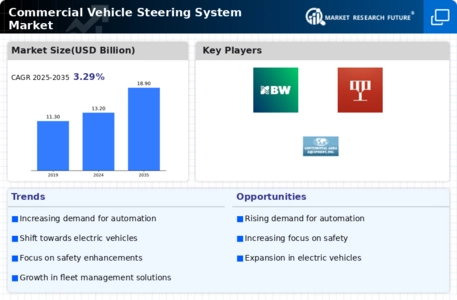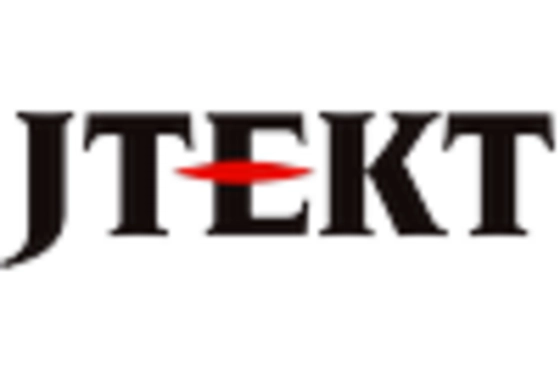Growth of Autonomous Vehicle Technologies
The Commercial Vehicle Steering System Market is poised for transformation with the growth of autonomous vehicle technologies. As the industry moves towards automation, the demand for advanced steering systems that can support autonomous functionalities is increasing. These systems must provide precise control and responsiveness to ensure safe operation in various driving conditions. Market forecasts suggest that the autonomous vehicle segment could experience a CAGR of over 15% in the next decade. This growth is likely to stimulate investments in research and development of steering technologies that can integrate seamlessly with autonomous systems. Consequently, the evolution of steering systems will play a crucial role in shaping the future of commercial vehicles.
Increasing Demand for Commercial Vehicles
The Commercial Vehicle Steering System Market is significantly influenced by the rising demand for commercial vehicles across various sectors. The logistics and transportation sectors are expanding, driven by e-commerce growth and urbanization. This surge in demand for commercial vehicles necessitates advanced steering systems that can provide better maneuverability and control. Market data indicates that the commercial vehicle segment is expected to witness a CAGR of around 5% in the coming years. As fleet operators seek to enhance operational efficiency, the need for reliable and responsive steering systems becomes paramount. Consequently, manufacturers are focusing on developing innovative steering solutions to meet the evolving requirements of the commercial vehicle market.
Regulatory Compliance and Safety Standards
The Commercial Vehicle Steering System Market is also shaped by stringent regulatory compliance and safety standards imposed by governments worldwide. These regulations aim to enhance vehicle safety and reduce accidents, thereby driving the demand for advanced steering systems. For instance, regulations mandating the installation of electronic stability control (ESC) systems in commercial vehicles have led to increased adoption of sophisticated steering technologies. Market analysis suggests that compliance with these regulations could lead to a market growth rate of approximately 6% over the next few years. As manufacturers strive to meet these safety standards, the development of innovative steering solutions becomes essential, further propelling the market forward.
Technological Advancements in Steering Systems
The Commercial Vehicle Steering System Market is experiencing a notable shift due to rapid technological advancements. Innovations such as electronic power steering (EPS) and steer-by-wire systems are becoming increasingly prevalent. These technologies enhance vehicle control and reduce weight, which can lead to improved fuel efficiency. According to recent data, the EPS segment is projected to grow at a compound annual growth rate (CAGR) of approximately 7% over the next five years. This growth is driven by the demand for enhanced driving comfort and precision. Furthermore, the integration of advanced driver-assistance systems (ADAS) with steering technologies is likely to bolster market growth, as these systems improve safety and operational efficiency in commercial vehicles.
Focus on Fuel Efficiency and Emission Reduction
The Commercial Vehicle Steering System Market is increasingly influenced by the global emphasis on fuel efficiency and emission reduction. As environmental concerns grow, manufacturers are compelled to develop steering systems that contribute to lower fuel consumption and reduced emissions. Advanced steering technologies, such as electric power steering, not only enhance vehicle performance but also support sustainability initiatives by minimizing energy loss. Recent studies indicate that vehicles equipped with modern steering systems can achieve up to 10% better fuel efficiency compared to traditional systems. This focus on sustainability is likely to drive innovation in the steering system market, as companies seek to align with environmental regulations and consumer preferences.


















Leave a Comment